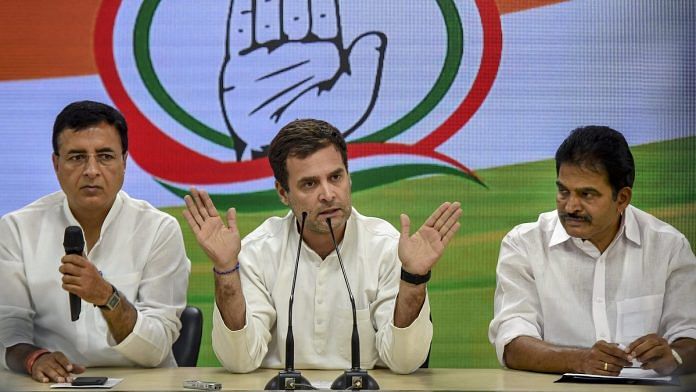New Delhi: On 31 March, Rahul Gandhi promised if the Congress returns to power it will increase education spending to 6 per cent of GDP from the current 4.6 per cent. This is the second such promise made by the Congress president recently. The first was the Nyuntam Aay Yojana (NYAY) scheme where nearly 2 per cent of GDP is planned to be spent as cash transfers to the poorest. Together that could mean a 4 per cent rise in GDP.
ThePrint looks at the implications of such additional expenditure and how it would be met.
GDP and expenditure
The magnitude of government spending is often referred to as a share of GDP to give a sense of how much of the country’s total output is being spent on a particular item.
However, it must be remembered that GDP is the value of goods and services produced in the country. Most of it is in private hands. It is the wages and incomes earned by households of India.
For the government to spend Rs 100 on anything, be it teachers’ salaries or building schools, it first has to have that much money. Spending 6 per cent of GDP means that the government would have to (i) spend less on something else, or (ii) tax people more, or (iii) borrow the money. Money that is with households of India cannot be spent by the government without one of the three happening.
The question is not whether the poor should have something to eat and schools to send their children to. Everyone agrees that they should. The question the Congress must answer clearly is — where will the money come from?
It has not explained whether GST rates will be higher, whether income tax and corporate tax will be raised, and if they are, how much will be the additional expected revenues from each source.
Also read: Rahul Gandhi’s NYAY raises too many questions & is not the answer to ending poverty
The danger of not saying what expenditure would be cut — if that is to be the path to garnering resources for additional spending — is that capital expenditure will be cut. That is what has usually happened in the past.
Between NYAY and this additional education spending, government expenditure could rise by around 4 per cent of GDP. If these promises are kept without cutting other spending or raising taxes, the government would be borrowing an additional amount almost equal to its total borrowing today, or even more. The FRMB (Fiscal Responsibility and Budget Management) target of 3.0 per cent of GDP would have to be given up.
Is Rahul Gandhi proposing an alternate path of fiscal consolidation?
To understand the macro implications of such large government spending plans without adequate plans to be fiscally prudent is important. The risks associated with higher fiscal deficits include a larger current account deficit as the country spends more. This can lead to pressure on the rupee, higher inflation, crowding out of private borrowing and investment, and higher interest rates. While expansionary fiscal policy (higher borrowing by government) could give the economy a period of higher growth, such demand-driven growth is likely to be unsustainable.
On a side note, in the context of education spending there are additional questions.
Is the present expenditure on education giving us bang for the buck? A recent study shows that, for example, at an average of Rs 47,044 in Gujarat, Rs 39,267 in Kerala, Rs 23,012 in UP per annum per student, government schools are spending much more than private schools without providing commensurately better learning outcomes. In other words, the money already being spent could be spent better before we plan to increase spending.
Also read: NYAY is product of same Meena Kumari politics that brought Congress to 44 in 2014 from 206



